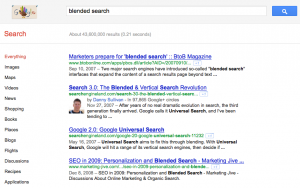Searching With My Good Eye Open – Understanding Blended Search
A third of all searches performed on Google now generate a blend of traditional website listings along with other media. If you are a commercial business owner or have a personal blog, understanding blended search results can help you better market your business.
How Did We Get Here?
When someone typically thinks of what a search engine does, the first answer is most likely to serve up web pages. This is true but the landscape has been changing for a while and it’s not just web pages that matter. In the beginning, text was the important thing. Websites didn’t contain much in the way of rich media because we were all on dial-up, and sites were generally built in HTML. Search engines were simpler, relying on html for text cues to match up sites to queries. In the late 90’s Google introduced a new search model that incorporated back links into the equation. Google continued to develop ways to make search results more relevant and useful. As technology improved, Internet and browser speeds increased, sites have become more robust, can now offer things like video, rich images, audio, interactive programming without fear of visitors not being able to get the full experience. Meanwhile, search engines have gathered more insight into searchers’ activity, what they’re looking for.
Know Your Ingredients

What are the different ways your business can be visible?
- Images
- Video
- News
- Local Listings
- Real Time Social Media
- Blogs
- Press Releases
- Shopping
- Maps
How many of you actually click on the sidebar? Perhaps a few and most likely only some of the many options. This has been a challenge for search engines trying to get the usability bit right or simply getting people to know about the options. This is why vertical search blends into the main page of results. This is also the clever part. The search engines try to push the most relevant verticals based on your browsing habits and strength of content. When Google came along, they placed a lot of emphasis on link juice and the value of who links to who. While this is still a pillar of SEO, it can be abused and is no longer the primary SEO strategy. A couple of main ways in which search engines are able to personalize your results are through: 1. Geo-Targeting with your IP Address – An good example is Google Places, which will put the most relevant local results at the top of page 1. If you have not claimed your Places business listing, do it now. 2. Behavioral Targeting – Typically this is when you see an advertisement for a product or company that you have shown interest in. If a search engine knows your location (via IP address), then it’s able to provide the most relevant local results. It also can place a 3rd party cookie, which will last for 30 minutes, to get data on your browsing habits. This will provide a greater context for the engine.
Start Blending for Visibility
To achieve position 1 on page one for a web page for a competitive key phrase is hard. It takes time, so while you work on this, take advantage of all the other ways in which you can get on page 1. So as I listed out earlier, try to create content in the various verticals. Without putting too finer point on it:
- Use copyright free or purchase images and tag them
- Create video and optimize for YouTube with good title and descriptions
- Use social media: Listen, Engage, Ask & Promote
- Have a blog hosted on your domain – Write regular, original content
- Claim your business listing with Google, Yahoo, Bing and others. Get started with www.getlisted.org
- Create White Papers or Press Releases
Remember, it’s not about gaming the system. Many have made that mistake with back linking strategies. The blended search algorithm brings your content, in context, to the right visitors. It’s simply about getting savvy to the various ways you can do this that will target you audience and you should want to create content if you’re serious about competing.
Where Are We Headed With Search?
You don’t have to be Einstein to know that crowd-sourcing plays an increasing role. Social media, review based SEO, tagging and bookmarking are already important factors. An additional algorithmic change right now, has been to include personalized, historical search such as click-through rate and time spent on a page. This will continue to play a big part in my opinion. It may take an Einstein however, to make the next break through such as voice recognition and artificial intelligence on a mass scale. Whatever is next, it will still have to serve the core mission of search engines, which is to deliver accurate, high quality results.









